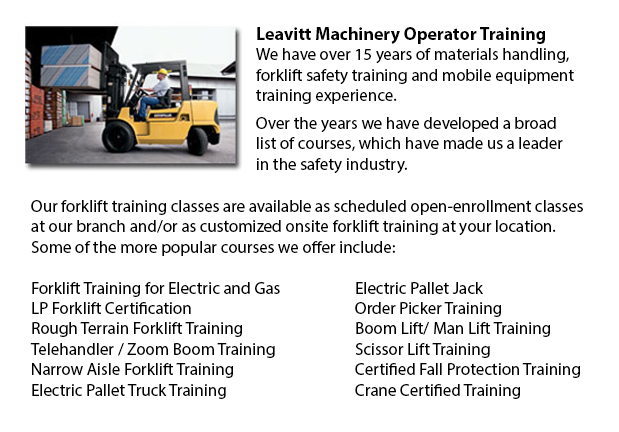
Oakville Forklift Training Programs - If you are searching for work as an operator of a forklift, our regulatory-compliant forklift training programs provide exceptional instruction in various types and styles of forklifts, classes on pre-shift inspection, fuel kinds and handling of fuels, and safe operation of a lift truck. Practical, hands-on training assists participants in acquiring fundamental operational skills. Program content covers current regulations governing the utilization of lift trucks. Our proven forklift programs are intended to provide training on these types of trucks: counterbalanced forklift, powered pallet trucks and narrow isle forklift.
How to Handle Loads Safely
Do not raise or lower the fork while the lift truck is traveling. A load must not extend over the backrest due to the danger of the load sliding back in the direction of the operator. Inspect for overhead obstructions and ensure there is plenty of clearance before lifting a load. Stay away from overhead power lines. Once the load is raised straight up, tilt it back slightly.
The lift truck is less steady if a load is in a raised position. Make certain that no one ever walks under the elevated fork. The operator should never leave the lift truck when the load is raised.
When handling pallets, forks must be high and level enough to go into the pallet and extend all the way below the load. The width of the forks must provide equal weight distribution.
Set the brakes and chock the wheels before loading and unloading the truck. The floors should be strong enough to support the combined weight of the forklift and its load. Fixed jacks can be installed to support a semi-trailer which is not attached to a tractor. The height of the entrance door should clear the height of the forklift by a minimum of 5 cm. Edges of ramps, docks and rail cars should be marked and avoid them.
Do not stay in a lift truck for a long time without right ventilation. The interior of the truck should be well lighted and free of obstructions, trash and loose objects. Check for holes in the floor. The installation of nonslip material on the floor would help prevent slipping. Clear whatever obstacles from dockplates and docks and ensure surfaces are not oily or wet.
Never tow or push other vehicles with a lift truck.
-
Oakville Overhead Crane Safety Training
Oakville Overhead Crane Safety Training - Overhead crane safety training equips operators with skills and knowledge regarding crane safety measures, accident avoidance, materials handling, and machinery and stock protection. Trainees will learn the t... More -
Oakville Crane Training Schools
Oakville Crane Training Schools - Our various Mobile Crane Operation programs are designed for skilled operators who needs re-certification or certification, and for inexperienced individuals who are seeking their very first job as an operator of a c... More -
Oakville Overhead Crane Certification
Oakville Overhead Crane Certification - The overhead crane certification course is a course that is designed to help trainees, even though they have language or literacy limits. The course consists of a classroom theory part and a practical hands-on... More -
Oakville Fall Protection Ticket
Oakville Fall Protection Ticket - The number one cause of death in the construction business come from fall-related accidents. There is more possibility for fall accidents depending on the types of work being performed within your workplace. Thus, be... More -
Oakville Zoom Boom Training
Oakville Zoom Boom Training - Zoom Boom Training focuses on correctly training potential operators on variable reach forklifts. The training objectives consist of gaining the understanding of the machine's physics and to define the job of the operato... More -
Oakville Aerial Lift Ticket
Oakville Aerial Lift Ticket - A boom truck is often recognized by the cable and telephone company vans that have the elongated arm folded over their roofs. Commonly, a bucket-like apparatus sits at the extension of extendable arms. Often referred to... More -
Oakville Scissor Lift Training
Oakville Scissor Lift Training - Scissor lifts need to be operated competently to be able to protect the safety of the machinery and the safety of people in the workplace. Operators who are skilled are trained to drive the specific model of scissor l... More -
Oakville Boom Lift Safety Training
Oakville Boom Lift Safey Training - Boom lifts are a type of elevated work platform or aerial lifting device which are commonly utilized in warehousing, construction and industry. Boom lifts could be made use of in almost whatever environment because... More

Forklift Certification Oakville
TOLL FREE: 1-888-254-6157
Oakville, Ontario
forkliftcertificationoakville.com
Email Us
About Us


